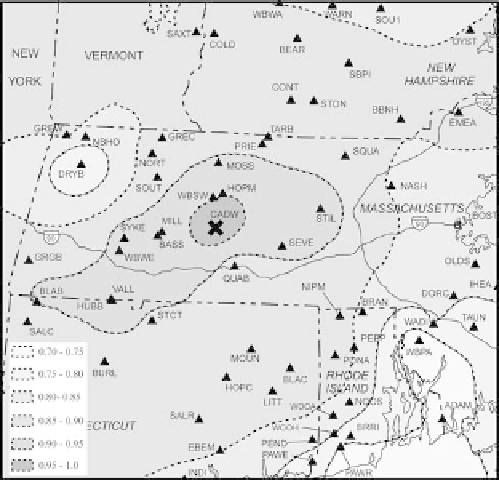Geography Reference
In-Depth Information
because the sizes of the drainage areas at the respective
catchments are different. For a given time, the drainage area
ratio method assumes that the runoff per unit area at the
donor and recipient catchments are equal and estimated
runoff is determined by the equation (in this case assuming
a linear relationship of mean flow with catchment area).
An extension of the drainage area method is the
maintenance-of-variance (MOVE) method (Hirsch,
1979
).
In this case the method assumes that the runoff values
differ only by the mean and standard deviation, and that
the time series normalised by both the mean and standard
deviation, i.e., (runoff
mean) divided by the standard
deviation, is preserved between the donor and recipient
catchments. In this case, the method works by regionalis-
ing both the mean and standard deviation between the
donor and recipient catchments. Note that both the drain-
age area ratio and MOVE methods use the runoff at the
analogue catchment to estimate both the magnitude and
timing of the runoff at the ungauged catchment.
One can go one step further: instead of regionalising just
the mean and the variance, one can regionalise the entire
within-year variability or probability distribution of runoff,
e.g., as expressed in the flow duration curve. Several authors
have used a two-part method to first estimate the flow dur-
ation curve at the ungauged catchment through an appropriate
regionalisation procedure, and used the timing of the observed
runoff at the donor catchment to determine the time series of
runoff at the recipient ungauged catchment (Fennessey,
1994
;
Hughes and Smakhtin,
1996
; Smakhtin et al.,
1997
;Smakhtin
and Masse,
2000
;Mohamoud,
2008
; Archfield et al.,
2010
;
Shu and Ourda,
2012
). For a given point in time the excee-
dance probability of the runoff of the donor is then used to
estimate the runoff at the ungauged site using the regionalised
flowduration curve. The flowduration curve can be estimated
by any number of methods as described in
Chapter 7
.
−
Figure 10.13. Estimated correlations between runoff at Cadwell
Creek near Belchertown, Massachusetts (CADW, indicated by the
cross) and any other location in the study region. Size of the area is
220 km across. From Archfield and Vogel (
2010
).
map correlation method, calculates the cross-correlation
coefficients of runoff with all the other stream gauges and
then interpolates these correlation coefficients in space
using kriging. The procedure is repeated for each of the
stream gauges. This means there will be a total of n maps
of correlations for n stream gauges in the region. For a given
ungauged catchment, the map out of the n maps is selected
for which the catchment outlet location corresponds to the
highest interpolated correlation coefficient. The stream
gauge from which that map was produced is then used as
the donor for the ungauged catchment.
Figure 10.13
pre-
sents one of the n correlationmaps produced by Archfield
and Vogel (
2010
). Although their method did not take the
stream network structure into account, they showed that
their method gave better runoff estimates than when choos-
ing the nearest stream gauge as the donor.
Harvey et al.(
2012
) compared various methods for esti-
mating runoff from short records for catchments in the UK,
and suggested that index methods based on transforming
exceedance probabilities and multiple regression approaches
performed best. They also showed that choice of the donor
station has a strong influence on the performance.
Selecting the donor catchment
The transfer methods presented all transfer the timing of the
runoff from the donor catchment to the ungauged catch-
ment. Whereas previous application of these methods
selected the donor catchment located closest to the
ungauged location or a stream gauge located upstream or
downstream of the ungauged location, if some runoff infor-
mation were known at the ungauged location, one would
use the correlation between the time series to select the
donor catchment, as is done in the MOVE methods (Hirsch,
1982
; Vogel and Stedinger,
1985
) for record augmentation
and patching. For this reason, Archfield and Vogel (
2010
)
developed a geostatistical approach to select the donor
catchment for runoff transfer methods that move the runoff
time series at a donor catchment to an ungauged location
where no measurements exist to estimate the correlation in
runoff between the two locations. The method, termed the
10.3.3 Geostatistical methods
Geostatistical methods (Gandin,
1963
; Matheron,
1963
)
exploit the spatial correlation of the variable of interest
and provide an estimate of that variable as the weighted

Search WWH ::

Custom Search